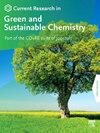Evaluation of azo dyes degradation potential of Staphylococcus strains: A strategy for dye-waste management
Q2 Materials Science
Current Research in Green and Sustainable Chemistry
Pub Date : 2024-01-01
DOI:10.1016/j.crgsc.2024.100432
引用次数: 0
Abstract
The current investigation aimed to identify the bacterial isolates that could prove helpful in the degeneration of harmful azo dyes from wastewater. The bacterial strains 1b, 1 m, and 4v could decolorize azo dyes up to 81 %, 79 %, and 87 % within 5 days. The degraded products by thin layer chromatography (TLC) showed Rf values of 0.89, 0.95, 0.90, 0.92, and 0.98 while the control showed an Rf value of 0.94. The comparison of the retention time of control and treated samples by the high-performance liquid chromatography (HPLC) system convinced that remarkable decolorization had occurred by the bacterial strains. The Fourier transform infrared spectroscopy (FTIR) analysis of the control and degraded samples was proof that the bond stretching occurred in the treated samples due to the action of bacterial strains. The release of compounds by bacteria i.e., 3-Aminobutanoic acid, pyrrolo pyrazine-1, 4-dione, and palmitic acid was inspected by Gas Chromatography-Mass Spectroscopy (GC-MS) analysis. No clear zones showed that the bacterial dye-degraded wastewater had no harm to the normal flora. At last, phytotoxicity was studied on Vigna radiata which had negative results. Given their pollutant degrading capabilities, these bacterial isolates are a good bioresource for green chemistry to exterminate azo dyes from the environment.
评估葡萄球菌菌株降解偶氮染料的潜力:染料废物管理策略
目前的研究旨在找出有助于降解废水中有害偶氮染料的细菌分离物。细菌菌株 1b、1 m 和 4v 能在 5 天内使偶氮染料脱色达 81%、79% 和 87%。降解产物的薄层色谱(TLC)显示 Rf 值分别为 0.89、0.95、0.90、0.92 和 0.98,而对照组的 Rf 值为 0.94。通过比较对照组和处理过的样品在高效液相色谱(HPLC)系统中的保留时间,可以确信细菌菌株的脱色效果非常显著。对对照组和降解样品进行的傅立叶变换红外光谱(FTIR)分析证明,在细菌菌株的作用下,处理过的样品中发生了键伸展。气相色谱-质谱(GC-MS)分析检测了细菌释放的化合物,即 3-氨基丁酸、吡咯并嗪-1,4-二酮和棕榈酸。结果表明,经细菌降解的染料废水对正常菌群无害。最后,还研究了植物毒性,结果为阴性。鉴于其降解污染物的能力,这些细菌分离物是一种很好的绿色化学生物资源,可用于消除环境中的偶氮染料。
本文章由计算机程序翻译,如有差异,请以英文原文为准。
求助全文
约1分钟内获得全文
求助全文
来源期刊

Current Research in Green and Sustainable Chemistry
Materials Science-Materials Chemistry
CiteScore
11.20
自引率
0.00%
发文量
116
审稿时长
78 days
 求助内容:
求助内容: 应助结果提醒方式:
应助结果提醒方式:


